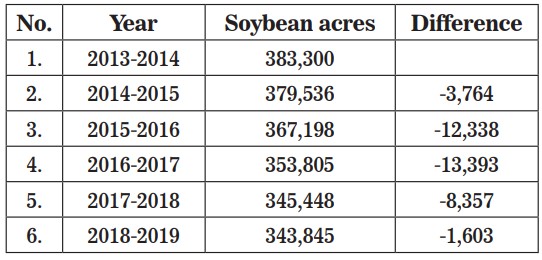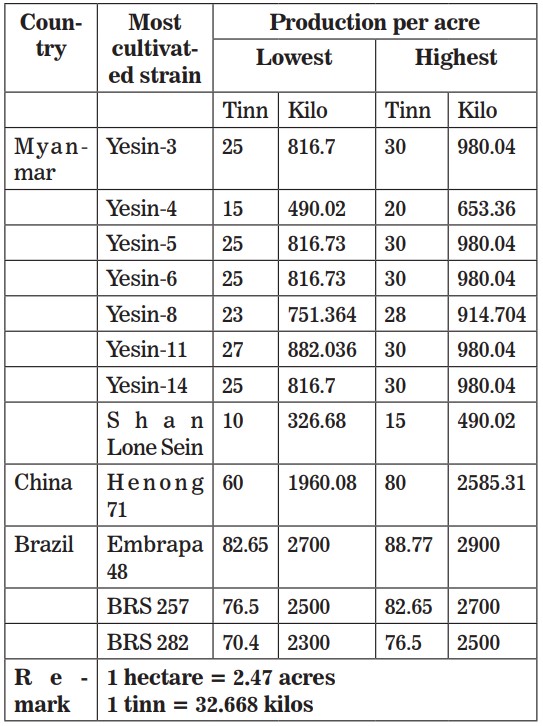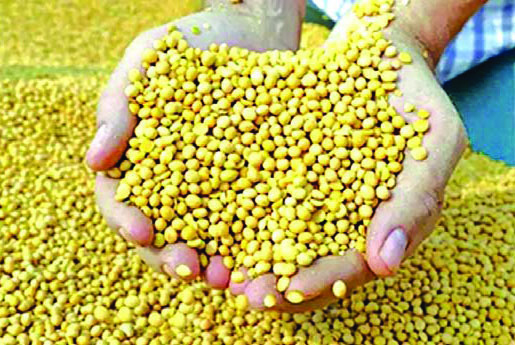30 June
MYANMAR people sometime confuse soybeans with horse grams, but they are very different. Still, some products confuse the two in their descriptions of ingredients, especially when some cooking oil mistakenly label soybean oil as horse gram oil. The truth is only soybeans can have vegetable oil extracted from their seeds while the horse gram cannot. The horse gram is actually used to make fermented bean paste in Upper Myanmar.
Soybeans can be used to make vegetable oil and has high amounts of protein and is considered a gift from nature. They can be used to make high-valued protein products and cooing oil. Soybean oil has been researched to provide numerous health benefits to people. However, natural soybean oil needs to be stored properly or it will not last long. Asia has the highest consumption of soybean in the form of soybean milk and different varieties of dishes.
Global soybean production reached 358 million metric ton in 2019 with America producing 95 million metric ton in 2019, a reduction of 20 million metric ton compared to 2018. Brazil produced 123 million metric ton of soybean in 2019 and became a world record. They are followed by Argentina, China, India, Paraguay, Canada, Mexico and some European countries in the list of highest soybean producers.
China is the sole consumer of 60 per cent of all soybean production, consuming well above a hundred million metric ton per year yet producing only 12 million metric ton annually. This means China imports some 88 million metric ton of soybean every year and is the largest target market for America and Brazil.
Soybean products
China also uses soybean as a nutritional replacement in such products as salted and preserved soya beans, soybean sauce, soybean vegetable oil, soy milk, and soy milk powder. Even the mashed beans left from extracting soybean oil can be used to make high-value products, especially in the production of substitute meat for vegetarians.
The result is that the demand for soybeans grows in China every year and experts estimate China will need about 120 million metric ton in 2020. This requirement was also a huge blow to China in the 2018 trade war. China retaliated to America’s increased tariffs on Chinese steel by placing restrictions on imports of American soybeans in early November of 2018. However, it became difficult to pacify the domestic market and the unpreparedness of warehouses caused more damage to China.
China also imports fulfills its demand for soybean from Brazil but it has to rely on routes in the South Atlantic Ocean to deliver to China. Brazil has two main routes to transport large ton of cargo to China. The first is passing the Panama Canal to the North Pacific Ocean and the second is going around Africa and into the Indian Ocean and South Pacific Ocean.
While the Panama Canal route is a better option for China, the authority that America influences over it makes it wary. Thus, China is planning to construct a 3,000-mile railway project from the east coast of Brazil to the west coast of Peru. Both Brazil and Peru seem to accept the project but there is another issue. About 70 per cent of that project’s scope passes through the Amazon Rainforest and it faces pressure from America concerning environmental issues.
Brazil, Argentina and South American countries have the potential to meet 60 per cent of China’s soybean demands. The remaining 40 per cent can most likely be fulfilled by East European nations, Africa and Southeast Asian countries, according to Hunan Agricultural University.
Myanmar is an agricultural country bordering China and part of the Belt and Road Intiative and thus has the potential to penetrate the large soybean market and enter the global stage. This is why we need to make effective preparation for soybean production. We can divide this into cultivation, industrial processing, and quality aspects.
Cultivation
The biggest challenge to Myanmar’s soybean production is the annual decrease in available farmland. The following table from reports by the Forest Department illustrates the issue:

Myanmar lost about 40,000 acres of farmland for soybeans in the span of 5 years. We will also need to select breeds that can produce high-quality soybeans and a lot of them as well. The varieties grown in America and Brazil contain an average 35% of oil while the average for the breeds cultivated in Myanmar varies from 12 to 30 per cent.
Hence, it is important for us to select breeds that contain high amounts of oil in their seeds. The following table illustrates the average production per acre of soybean farms in Myanmar with the strains planted in China and Brazil.

The production rate of soybean greatly depends on environmental factors and the plants favour long nights and shorter days when they flower. The pigments of the plant undergo photoisomerization and the process is efficiently faster in night temperatures of under 21 degrees.
Industrial processing
Myanmar needs to conduct market and value chain research to develop its soybean production. The concerned organizations need to regularly survey the global soybean market and conduct continuous research. Similarly, they must also research the methods of production and preparation utilized along the soybean consumption value chain and apply it in regional production sector.
For example, the FOB price for a metric ton of raw soybean is around $ 370 but the price of a tonne of ground soybean with the oil extracted is over $ 350. A tonne of soybean oil fetches around $ 820 which means if a tonne of soybean variety that only contains 15 per cent oil had the oil extracted, it would produce a tonne of $ 123 worth of soybean oil and a tonne of mashed beans worth $ 298, combining to produce $ 421 from both products.
This estimate was calculated using the lowest production rate and oil ratio data and still produced $ 51 more than simply selling a tonne of raw soybean. The quality of the soybean and production technology can determine the profit to be made.
Soybean contain such medically beneficial organic chemical compounds like isoflavones and phospholipids that have become a daily requirement for good health. Countries such as those in Europe, China, India and Japan extensively use and produce soybean. It will greatly benefit the nation if Myanmar can acquire the foreign technology and investments to reach global soybean production standards in the future.
Quality
Myanmar’s soybean shipments are noticeably increasing with each year as it rose from just 1,700 tonnes in 2016 to over 2,000 tonnes in 2017 and then went above 7,000 tonnes in the 2018-2019 financial year with a marked increase in foreign market demand as well.
While the trade war between the two superpowers of America and China can be said to have increased Myanmar’s soybean export to meet Chinese demand, we have also exported about 3,000 tonnes to India through nautical channels as well.
Soybeans’ quality sector concerns both the export of raw soybeans and the production of high-value products. This is why Myanmar needs to select the best strains of soybean for cultivation and use Good Agricultural Practices (GAP) system as well.
We also need relevant government departments to provide technological assistance and research to protect the crops from disease before they are reaped and to prevent wastage after harvest.
The Standardization of Agro-based Products Technical Sub-committee is compiling the draft quality standards for Myanmar soybeans. The next step is to collaborate with all stakeholders to penetrate the global soybean market and implement quality and market development across Myanmar.
By Maung Maung (MOC) (Translated by Pen Dali)




